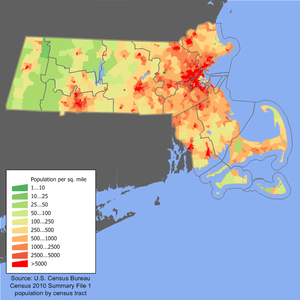Massachusetts has an estimated population of 6.981 million as of 2022 according to the U.S. Census Bureau.[1] This represents a −0.7% decrease in population from the 2020 census, when the population was 7.029 million. Currently, Massachusetts is the sixteenth most populous U.S. state.
| Census | Pop. | Note | %± |
|---|---|---|---|
| 1790 | 378,787 | — | |
| 1800 | 422,845 | 11.6% | |
| 1810 | 472,040 | 11.6% | |
| 1820 | 523,287 | 10.9% | |
| 1830 | 610,408 | 16.6% | |
| 1840 | 737,699 | 20.9% | |
| 1850 | 994,514 | 34.8% | |
| 1860 | 1,231,066 | 23.8% | |
| 1870 | 1,457,351 | 18.4% | |
| 1880 | 1,783,085 | 22.4% | |
| 1890 | 2,238,947 | 25.6% | |
| 1900 | 2,805,346 | 25.3% | |
| 1910 | 3,366,416 | 20.0% | |
| 1920 | 3,852,356 | 14.4% | |
| 1930 | 4,249,614 | 10.3% | |
| 1940 | 4,316,721 | 1.6% | |
| 1950 | 4,690,514 | 8.7% | |
| 1960 | 5,148,578 | 9.8% | |
| 1970 | 5,689,170 | 10.5% | |
| 1980 | 5,737,037 | 0.8% | |
| 1990 | 6,016,425 | 4.9% | |
| 2000 | 6,349,097 | 5.5% | |
| 2010 | 6,547,629 | 3.1% | |
| 2020 | 7,029,917 | 7.4% | |
| 2022 (est.) | 6,981,974 | −0.7% | |
| Sources:[1][2][3] | |||
Massachusetts has seen both population increases and decreases in recent years. For example, while some Bay Staters are leaving, others are moving there including European, Asian, Hispanic, African, Middle Eastern, North American, and Australian immigrants. Massachusetts in 2020 included 1.2 million foreign-born residents.

Most Bay Staters live within a 60-mile radius of the State House on Beacon Hill, often called Greater Boston: the City of Boston, neighboring cities and towns, the North Shore, South Shore, the northern, western, and southern suburbs, and most of southeastern and central Massachusetts. Eastern Massachusetts is more urban than Western Massachusetts, which is primarily rural, save for the cities of Springfield, Chicopee, Holyoke, and Northampton, which serve as centers of population density in the Pioneer Valley of the Connecticut River. The center of population of Massachusetts is located in Middlesex County, in the town of Natick.[4]
- ^ a b "US Census Quickfacts, Population Estimates, July 1 2022". Census.gov. United States Census Bureau. Archived (PDF) from the original on April 26, 2021. Retrieved July 11, 2023.
- ^ "Annual Estimates of the Resident Population for the United States, Regions, States, and Puerto Rico: April 1, 2000 to July 1, 2009". United States Census Bureau. Archived from the original on January 3, 2010. Retrieved December 23, 2009.
- ^ "Historical Population Change Data (1910–2020)". Census.gov. United States Census Bureau. Archived from the original on April 29, 2021. Retrieved May 1, 2021.
- ^ Population and Population Centers by State: 2010 Archived February 22, 2015, at the Wayback Machine. United States Census Bureau. Retrieved February 5, 2017.
